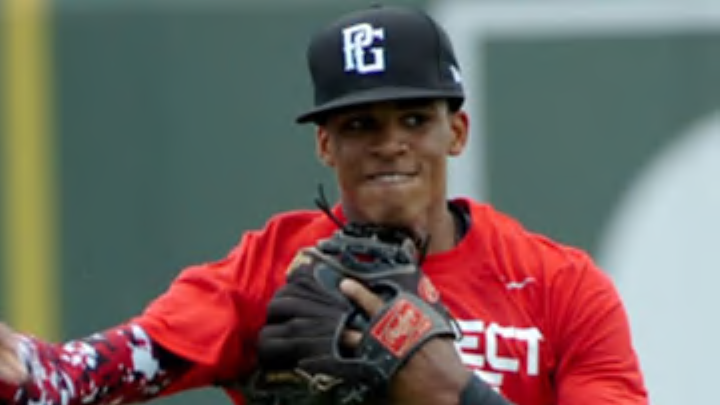Before we begin breaking down the top three infield prospects in the 2016 MLB Draft, let us add this little note before we get too overly involved… we don’t see any of these players in the fold for the #2 overall pick at this point in time.
While we would put money on the last two sluggers not breaking into the top 10, our first prospect sits there now and may go even higher when the draft rolls around.
10) Delvin Perez, SS, International Baseball Academy (Puerto Rico)
Scouting Grades: Hit: 50, Power: 40, Run: 60, Arm: 60, Field: 60, Overall: 55
Look at those fielding-related scores! 60-60-60, meaning Perez is the real deal when it comes to fielding his natural SS position; however, he also has a “50” hit tool according to MLB.com, so he may just hit enough to be a top-of-the-lineup bat if he progresses well. While not a lot is known by the average baseball fan about foreign prospects, Perez is the kind of INF prospect that has scouts (and teams drafting from #7 on) salivating over his long-term ability.
MLB.com think Perez could be a late-mover up draft boards, so don’t be surprised if he is taken before his current #10 rank, as they wrote:
Perez has everything needed to stay at shortstop long-term. He has good speed and instincts, allowing him to have outstanding range. Perez’s plus arm works very well from everywhere, and his hands work extremely well. Able to make the flashy play, perhaps his only flaw defensively is that he can try to do too much on occasion. Perez’s bat is behind his glove, but there are tools to work with. He can ambush a fastball early in the count, but his approach at the plate and pitch recognition need to be refined. Perez’s speed works offensively, and he could grow into more power as he matures.
Premium middle infielders are hard to come by. If Perez comes out in the spring and shows improvement with the bat, it would not be out of the question to see him move even further up this list.
14) Nick Senzel, 3B, Tennessee
Scouting Grades: Hit: 55, Power: 50, Run: 50, Arm: 55, Field: 45, Overall: 50
Senzel had a solid two-year run at Tennessee, before completely lighting the Cape Cod League on fire last summer. He led the league in runs, hits, doubles, RBIs, extra-base hits, total bases, slugging and OPS–which earned him MVP honors as well as the Top Prospect Award.
So, basically… this kid can rake.
The only question is whether he can field, as he shifted from DH to 2B, then 2B to 3B, during the past two years.
MLB.com comments:
… combines strength and bat speed from the right side of the plate, and his patient all-fields approach should help him to hit for both average and power. Senzel exhibits average to solid speed and has the instincts to steal a few bases.
Senzel’s proponents believe he has the arm and athleticism to stay in the infield, while other evaluators question his hands and quickness and think he’s destined for the outfield.
15) Bobby Dalbec, 3B, Arizona
Scouting Grades: Hit: 45, Power: 60, Run: 30, Arm: 60, Field: 45, Overall: 50
Our “Pedro Cerrano Award” winner, Dalbec absolutely abuses fastballs but seems unable to put the bat on a breaking ball, which led 64 Ks in only 138 ABs between Team USA and the Cape Cod League. Although his strikeout rate is incredibly high, he did lead the Cape Cod League in HRs (way to let that one get away, Senzel!) with 14.
Dalbec’s bread and butter is his power. MLB.com think somebody will take a chance on him in the top 15 because of this… and not his K-rate, cement shoes or average glove. They said:
Dalbec’s power from the right side is legit and he can hit the ball out of any park. He can truly punish a fastball, but he’s struggled with offspeed stuff, and there’s obviously a ton of swing and miss to his game. Dalbec will draw a fair share of walks, giving him at least a chance to be a three true outcomes kind of hitter. Defensively, he has a strong arm that has allowed him to touch the mid-90s out of the Wildcats’ bullpen the past two years, but his below-average speed could push him to first base eventually.
Legitimate college power bats are typically high in demand but short in supply. If Dalbec can show a better ability to make contact in the spring, he’ll do just fine on Draft day.
